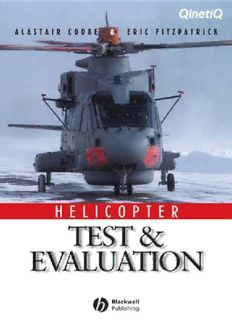
Helicopter Test and Evaluation (Aiaa Education Series) PDF
Preview Helicopter Test and Evaluation (Aiaa Education Series)
Helicopter Test and Evaluation HELICOPTER TEST AND EVALUATION Alastair K. Cooke BTech, BEng, MSc, PhD, CEng, MRAeS, MIMechE Eric W. H. Fitzpatrick MRAeS, Test Pilot ©QinetiQLimited2002 Firstpublished2002byBlackwellScienceLtd BlackwellScienceLtd,aBlackwellPublishing LibraryofCongress Company Cataloging-in-PublicationData EditorialOffices: Cooke,AlastairK. OsneyMead,OxfordOX20EL,UK Helicoptertestandevaluation/AlastairK. Tel:ò44(0)1865206206 Cooke,EricW.H.Fitzpatrick. BlackwellScience,Inc.,350MainStreet, p.cm. Malden,MA02148-5018,USA Includesbibliographicalreferencesandindex. Tel:ò17813888250 ISBN0-632-05247-3(Hardcover) BlackwellScienceAsiaPtyLtd,54University 1. Helicopter–Flighttesting. Street,CarltonSouth,Melbourne,Victoria 2. Helicopters–Aerodynamics. 3053,Australia I. Fitzpatrick,EricW.H. II. Title. Tel:ò61(0)393470300 TL716.5.C662002 BlackwellWissenschaftsVerlag, 629.133@352@0287–dc21 Kurfu¨rstendamm57,10707Berlin,Germany 2002010325 Tel:ò49(0)303279060 ISBN0-632-05247-3 TherightoftheAuthortobeidentifiedasthe AuthorofthisWorkhasbeenassertedin Acataloguerecordforthistitleisavailable accordancewiththeCopyright,Designsand fromtheBritishLibrary PatentsAct1988. SetinTimesNewRoman Allrightsreserved.Nopartofthispublication byAccComputing,NorthBarrow,Somerset, maybereproduced,storedinaretrieval GreatBritain system,ortransmitted,inanyformorbyany PrintedandboundinGreatBritainby means,electronic,mechanical,photocopying, MPGBooksLtd,Bodmin,Cornwall recordingorotherwise,exceptaspermittedby theUKCopyright,DesignsandPatentsAct Forfurtherinformationon 1988,withoutthepriorpermissionofthe BlackwellScience,visitourwebsite: publisher. www.blackwell-science.com Contents Preface vii Abbreviations x Notation xiii Chapter1 TheFlightTestProcess 1 1.1 Introduction 1 1.2 Flighttestplanning 1 1.3 Conductingthetrial 5 1.4 Post-trialsactions 6 Chapter2 PerformanceTheory 8 2.1 Introduction 8 2.2 Axialflight:momentumtheory 8 2.3 Axialflight:bladeelementtheory 11 2.4 Non-dimensionalcoefficients 14 2.5 Axialflight:improvedtheoreticalestimates 16 2.6 Axialflight:verticaldescentsandthevortex-ringstate 20 2.7 Horizontalflight:momentumtheory 22 2.8 Horizontalflight:bladeelementtheory 26 2.9 Horizontalflight:improvedtheoreticalestimates 29 2.10 Tailrotorpower 34 2.11 Powereddescents 36 2.12 Autorotation 44 2.13 Autorotativeperformance 51 2.14 Flarecharacteristicsandengine-offlandings 54 2.15 Theavoidcurve 60 Chapter3 PerformanceTesting 65 3.1 Introduction 65 3.2 Non-dimensionalparameters 65 3.3 Performancetestplanning 68 3.4 Levelflightperformancetesting 71 3.5 Verticalperformancetesting 87 3.6 Climbperformancetesting 106 3.7 Determinationofperformancelimitedparameters 115 v vi Contents Chapter4 StabilityandControlTheory 119 4.1 Introduction 119 4.2 Aero-derivativesforrotorcraft 120 4.3 Equationsofmotionforarigidairframe 125 4.4 Equationsofflappingmotion 128 4.5 Flapdynamics 132 4.6 Rotorcontributionstostaticanddynamicstability 146 4.7 Longitudinalstaticstability 150 4.8 Manoeuvrestability 152 4.9 Longitudinaldynamicstabilityandcontrolresponse 153 4.10 Lateral/directionalstaticstability 163 4.11 Lateral/directionaldynamicstabilityandcontrolresponse 167 Chapter5 StabilityandControlTesting 179 5.1 Assessingflightcontrolmechanicalcharacteristics 179 5.2 Assessingstaticstability 185 5.3 Manoeuvrestabilitytesting 194 5.4 Documentingdynamicstabilitycharacteristics 198 5.5 Timedomainmethodsforcontrolresponsetesting 202 5.6 Frequencydomainmethodsforcontrolresponseassessment 211 5.7 Missiontaskmethods 220 Chapter6 HelicopterSystems 231 6.1 Introduction 231 6.2 Airdatasystems 231 6.3 Enginecontrolandrotorgoverningsystems 239 6.4 Flightcontrolsystems 261 6.5 Automaticflightcontrolsystems 264 Chapter7 SystemsTesting 295 7.1 Methodology 295 7.2 Cockpits 298 7.3 Pressureerrormeasurement 310 7.4 Engineandrotorgoverning 319 7.5 EffectofAFCSonhandlingqualitiestesting 329 7.6 Failuretesting 338 References 357 Index 361 Preface The authors of this book have been employed at the Empire Test Pilots’ School (ETPS), part of QinetiQ, for the past ten years instructing student test pilots and flighttestengineersonhelicoptertesting.AlastairCookehasamastersdegreeinflight dynamicsfromCranfieldUniversityandgraduatedasaflighttestengineerfromETPS in 1989. Eric Fitzpatrick is a former military helicopter pilot and instructor who graduatedasatestpilotfromETPSin1986. Thisbookhasbeenproducedusingtheexperienceoftheauthorsinflighttestand flight test training gained over a combined period of 25 years in the field. Much of the material has its origin in the training notes produced by ETPS. These have been developed over a period of over forty years since the start of specific training for helicoptertestpilots.Thebookhasbeendesignedtoappealtoprofessionalsworking in the area of rotorcraft test and evaluation but it is hoped that it will also prove usefultoawideraudience.Inourexperience,wehavefoundthathelicopterpilotsare generally not well informed about the process that has led to their aircraft entering service,noraboutwhyithascertainlimitationsimposedonit.Wehopethisbookwill provide pilots with this information as well as being a useful text for practising engineers and technologists. The rotor theory presented is more extensive than is found in most aeronautical degree courses and so the book should prove useful to graduatesspecializinginrotorcrafttechnology.Perhapsuniquely,thisworkapproaches thisimportantsubjectfromboththetheoreticalandpracticalviewpoints. Foreachtopicthetheoryisexplainedbrieflyandisthenfollowedbydetailsofthe practicalaspectsoftestingahelicopter.Thesedetailsincludethesafetyconsiderations relatedtotheanticipatedtests,planningtheteststhemselves,and,whereappropriate, the most efficient way to conduct individual flights. Following a description of each type of test, typical results are examined and an explanation given as to why they would be important to the clearance process. Whenever possible examples of actual test results have been presented and used in the subsequent discussion. The book is splitintofourmainsections: Ω Introduction: covering a methodology for testing and general aspects of test programmes. Ω Performance: in this section level flight, vertical and climb/descent performance is addressed. The planning of performance trials is covered together with the methodsforairbornedatagatheringandanalysisofresults. Ω Handling qualities: this is a major section and covers the basics of helicopter stabilityandcontroltesting.Alsoincludedarefrequencydomainmethodsandthe useofmissiontaskelements. Ω Systems:inthissectionthemajorsystemsrequiredtoenableahelicoptertoflyare vii viii Preface covered.Thisincludesassessmentofthecockpit,airdatasystems,enginecontrol systems,andautomaticflightcontrolsystems.Alsoaddressedinthissectionisthe testingofsystemfailures. Althoughhighlyspecialized,thetopicofhelicoptertestingisstillvastandnosingletext couldhopetocovereverything.Theauthorshaveattempted,therefore,toconcentrate on the most important aspects using their own knowledge of the subject as a guide. Inevitably,anumberofimportantareashavenotbeencovered;forexample,ithasnot beenpossibletoincludeinformationonspecialistareassuchasunderslungloadtrials, deck operation trials or armament testing. The amount of information on systems testingtoincludeinthebookwasadifficultdecisionduetotheplethoraofsystemsthat canbefittedtoamodernrotorcraft.Consequently,itwasdecidedtodetailthegeneral methodologyusedinthistypeoftestingandthentoconcentrateonsystemswhichare intrinsictotheoperationofallhelicopters.Thus,ithasnotbeenpossibletoincludethe testingofhydraulics,electricsandlubricationsystems.Similarlythetestingofanumber ofcockpitsystemssuchaspilotingvisionaids,navigationsystems,weapons,andmission displayswereconsideredtobebeyondthescopeofthisbook.Finally,itwasnotpossible toincludesometypesoftestingwhichoftenplayalargepartinthelifeofatestpilot suchasenvironmentaltrials,notablycoldweatherandicing.Despitetheseomissions,it isbelievedthatthebookcoversalltheessentialareasofrotorcrafttestingandwillprove usefultoalargepartofthehelicoptercommunity.Astheauthors’backgroundhasbeen in military test and evaluation this has clearly influenced the subject matter that has been presented. However, most of the information given in the book can be applied, withonlyminormodification,tothetestingofcivilrotorcraft. BeforeclosingwewouldliketoacknowledgethehelpofMrMikeCookofCranfield University,MrMarkRootsofQinetiQLtdandMissJuliaBurdenofBlackwellPub- lishinginhelpingusdevelopourmanuscriptforpublication. AlastairCookeandEricFitzpatrick ETPS,QinetiQLtd MODBoscombeDown Copyrightacknowledgements Thefollowingorganizationsaregratefullyacknowledgedforgrantingpermissionsfor theuseofcopyrightmaterial. The UK MOD for the cover photograph. NASA for Figure 3.37 and the AHS for Figures3.18,3.20and3.22. Theexamplehelicopter On several occasions throughout this book quantitative calculations have been made tosupportthetheoreticaltrendsbeingdiscussed.Wherepossiblethecalculationshave been made using the same baseline data, referred to as the example helicopter. The Preface ix detailsofthishelicopter,whichislooselybasedontheWestlandLynx,aresummarized below: Mainrotor Radius 6.5m Bladechord 0.4m Standardrotorspeed 35rad/s Numberofblades 4 Liftcurveslope 0.1/º Twist 10º Profiledragcoefficient 0.008or0.01 Tailrotor Tailarm 7.5m Radius 1.1m Bladechord 0.2m Standardrotorspeed 165rad/s Numberofblades 4 Profiledragcoefficient 0.010 Fuselagefrontaldragarea 2m2 Fuselageverticaldragarea 8m2 Mass(unlessotherwiseindicated) 5000kg
